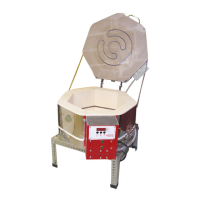FUSED GLASS PROJECTS
Working with Tested Compatible Glasses
To ensure success when fusing glass, use glass that has been pre-tested by the
manufacturer
How to prepare your glass project
Select glass that is “tested compatible” and has the same COE (Coefficient of
Expansion) for the entire project.
Glass projects should be comprised of two or more layers of glass from edge to
edge because at a full fuse, glass likes to be approximately ¼” (6mm) thick. The
best designs are constructed using a single piece of glass for the base piece,
with a cut design as the second layer. If you‟d like you can add more detail to
your design with frit, stringers, and confetti. During assembly, take the time to
make sure your glass pieces fit well together. If necessary, use a glass grinder
to aid with the fit. A helpful tip to reducing and eliminating grinder marks from
showing up in your fused pieces is to use an extra fine grit grinder bit.
Oil from your glass cutter, as well as oil from your fingers while handling the
pieces, is left on the surface of the glass. Thoroughly clean your glass pieces
with either a light detergent, like Dawn dishwashing detergent, and water or with
denatured alcohol. If you did any heavy grinding, also use a soft bristled brush,
like an old toothbrush, to scrub the edges and remove any residual ground glass
debris. After the glass had been cleaned and dried well, only handle it by the
edges when assembling your project.
To make transporting your project between your workspace and the kiln easier,
you can use water soluble glue. Use glue very sparingly on the backside of the
glass. Allow the glue to completely dry before you try to move your piece.
Before setting up your glass projects on the kiln shelf, first place the kiln shelf in
the kiln. If you are planning to fire more than one piece at a time, make sure to
position your glass projects no closer than ¾” to 1” to each other and also no
closer to the edge than ¾”.
Firing your Glass Project
When you first start fusing, the entire process
may seem to be complicated, but it‟s really
simpler than it may have originally sounded.
Fusing is all about controlled heating and
cooling of glasses in a kiln. As glass is being
fired in a kiln it goes through many physical
changes based on the temperature zone that
it‟s in.
Below 1000°F (538°C), glass is very rigid and is very susceptible to thermal
shock, or breaking, if heated or cooled too quickly. Visually, the glass appears to
be very rigid and it will look the same as if it were room temperature. Resist the
temptation to open the kiln and peek inside, because glass is very fragile at this
point and large temperature swings in the kiln will cause the glass to break.

